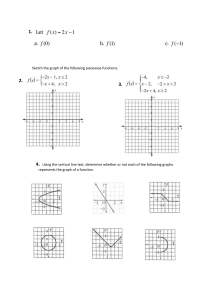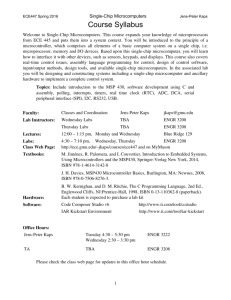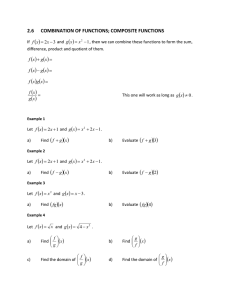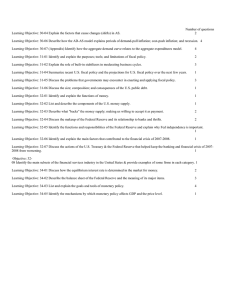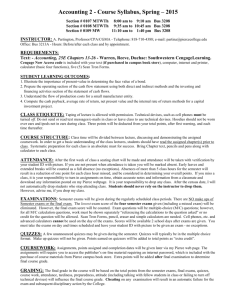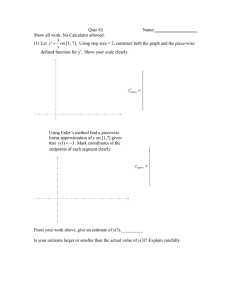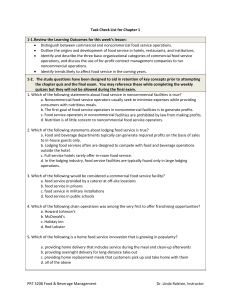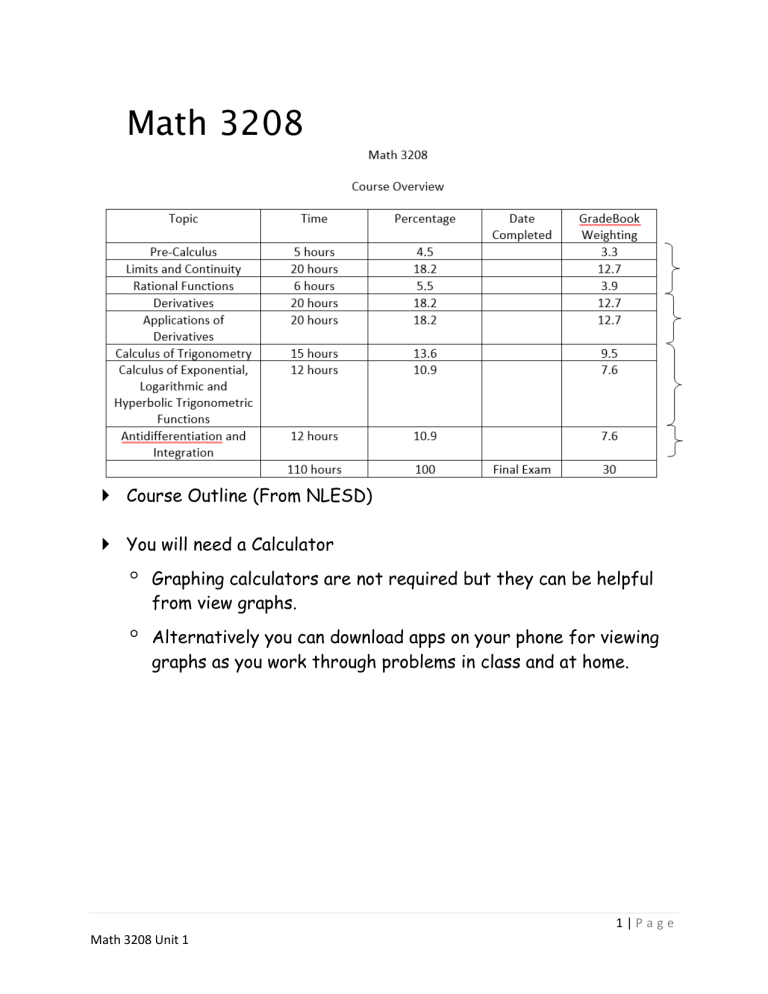
Math 3208 Course Outline (From NLESD) You will need a Calculator ◦ ◦ Graphing calculators are not required but they can be helpful from view graphs. Alternatively you can download apps on your phone for viewing graphs as you work through problems in class and at home. 1|Page Math 3208 Unit 1 Unit 1 Pre-Calculus Functions 1.1 _______________________________ 1.2 _______________________________ Introduction In this section we’re going to make sure that you’re familiar with functions and function notation. Both will appear in almost every section in a Calculus class and so you will need to be able to deal with them. We will work with the operations of functions. We will add, subtract, multiply, and divide functions to create new functions. Finally we then progress to composite functions where we will determine functional values and identify the domain and range of the composite function. What exactly is a function? An algebraic expression will be a function if for any __ in the __________ of the expression (the domain is all the ___that can be ______________ into the equation) the expression will yield _________________ value of y. 2|Page Math 3208 Unit 1 Example 1 Determine if each of the following are functions. (a) y = x2 + 1 This first one ________ ___________. Given an x, there is ____ ____ way to square it and then add 1 to the result. So, no matter what value of x you put into the equation, there is ______ __________________. (b) y2 = x + 1 The only difference between this equation and the first is that we _______________ ____________ off the x and onto the y. This small change is all that is required, in this case, to change the equation from a function to something that _________________. To see that y2 = x+ 1 isn’t a function is fairly simple. Choose a value of x, say x=3 and plug this into the equation. Solve for y. Since there are ________________________ of y that we get from a single x this equation __________________________. How can we tell from a graph of an equation whether it is a function or not? _______________________________ 3|Page Math 3208 Unit 1 Sketch the previous 2 functions using technology (a) y = x2 + 1 (b) y2 = x + 1 y y x x Next we need to take a quick look at function notation. Function notation is nothing more than a fancy way of __________ the y in a function to something such as f(x). Let’s take a look at the following function: Using function notation we can write this as any of the following: Recall that this is NOT a letter ________ x, this is just a fancy way of writing y. So, why is this useful? 4|Page Math 3208 Unit 1 With this notation, you can now use _______________________ _______________ at a time without confusing yourself or mixing up the formulas It provides an efficient way to __________________________. ◦ If we want to find the value of a function at a particular value, we can just say _____________ rather than saying ________ _______________________________________________. How do we go about evaluating functions? First, remember this: While parentheses have, up until now, always indicated multiplication, the parentheses ___________________ ______________________ in function notation. ◦ ________________________________ The expression "f (x)" means ___________________________ __________________________________________; ◦ ◦ the expression does _____ mean ______________________ Don't embarrass yourself by pronouncing (or thinking of) "f(x)" as being "f times x". In function notation, the "x" in "f (x)" is called "the __________ of the function", or just ________________________. ◦ So if we give you "f (2)" we are asking to ______ 2 into _____ ________________________________________. 5|Page Math 3208 Unit 1 Examples Given f (x) = x2 + 2x – 1, find f (2). Given g(x) = x3 + 2x2 – 1, find g(–3). NOTE: Using parentheses as we just did above helps keep track of things like whether or not the exponent is on the "minus" sign. Remember that "x" is just a _____, waiting for something to be put into it. Example: Given f(x) = -x2 +6x -11, find each of the following: A) f(2) B) f(-10) c) f(t) 6|Page Math 3208 Unit 1 Domain and Range The ___________ of a function is the set of all ____ that we can plug into the function and get back a ______________ for y. ◦ At this point, that means that we need to ________________ ________________ and taking _______________________ ____________________________. The ___________ of a function is the set of all ____ that we can ever get out of the function. Determining the range of a function can be _______________ to do for many functions. This is where _______________________ comes in handy. Determine the domain and range of the following A) f(x) = x2 + 1 7|Page Math 3208 Unit 1 B) C) In this case we’ve got a fraction, but notice that the denominator will never be _______ for any real number since ___ is guaranteed to be ___________________________________ onto this will mean that the denominator is always ___________. ◦ In other words, the denominator won’t ever be ___________. So, all we need to do then is worry about the ________________ _______________________________. 8|Page Math 3208 Unit 1 D) In this final part we’ve got both a _______________ and _____ _________________ to worry about. 9|Page Math 3208 Unit 1 Piecewise Functions A function that is defined by __________________________ The graph is drawn y by ______________ and _________ the part that is _____ in the restricted x domain. What is the Domain and Range of the Function? 10 | P a g e Math 3208 Unit 1 In math 2200 you used piecewise functions to describe Absolute Value functions EXAMPLE: Given the graph of : y f (x ) a) sketch the graph of y f (x ) b) state the domain and range c) express y f (x ) as a piecewise function. 11 | P a g e Math 3208 Unit 1 Other piecewise functions 2x 4, x 2 1. Sketch the function of: f (x ) 3 3x , x 2 y x State the domain and range 12 | P a g e Math 3208 Unit 1 x 2, x 2 2.A) Draw f (x ) 2 x 1, x 2 B) Find Domain and Range C) What value, instead of ____, would make this function have all reals for the range? 13 | P a g e Math 3208 Unit 1 x 2 2, x 1 3. Consider: f (x ) x 2, x 1 A) Find f(-1) B) Find: f(10) C) Find x when f(x) = 6 D) Sketch y = f(x) 14 | P a g e Math 3208 Unit 1 Practice: Page 9 and 10 #39, 41, 42 15 | P a g e Math 3208 Unit 1 1.1 Combining Functions Functions can be_____________________________________ ______________________________ to form new relationships between variables. In the last set of problems there were many illustrations of this. For example what combination of functions resulted in Definition: sum, difference, product, quotient functions Suppose f and g are given functions. Functions denoted by f + g, f – g, f g, and f are given by: g Sum: Difference: Product: Quotient: The domain of each combined function is the set of all real numbers for which the right side of the equation _____________ __________________________________________________ 16 | P a g e Math 3208 Unit 1 Combination by Addition/Subtraction Consider functions: f(x) = x2 + 8 g(x) = 6x A) Complete the table B) Plot y = h(x) What is the shape of h(x)? y What type of function is h(x)? x What is the relationship between the domains of f(x), g(x) and h(x)? 17 | P a g e Math 3208 Unit 1 C) Find h(x) algebraically Vertex: Intercepts: D) How does the answer from part C compare to the graph in part B)? How can we find the graph of either f(x) + g(x), (or f(x) – g(x)) if we are only given the graphs of y = f(x) and y = g(x)? ◦ _______________________________________________ _______________________________________________ _______________________________________________ 18 | P a g e Math 3208 Unit 1 Graph the sum of these two graphs: y x 19 | P a g e Math 3208 Unit 1 Graph the difference of these two graphs: y x 20 | P a g e Math 3208 Unit 1 Complete the table of values below where: h(x) = f(x) + g(x) and k(x) = f(x) – g(x) 21 | P a g e Math 3208 Unit 1 Examples: Find h(x) and its domain and range A) h(x) = (f + g)(x) where f(x) = 2x and g(x) = 3x+2 B) h(x) = (f - g)(x) where f(x) = 2x2 -3x + 3 and g(x) = 3x2 -3x+2 22 | P a g e Math 3208 Unit 1 C) h(x) = (f - g)(x) where f (x ) x 1 and g(x) = 2 D) h(x) = (f +g)(x) where f(x) = |x – 1| and g(x) = 2 23 | P a g e Math 3208 Unit 1 Product and Quotient of Functions Determining the product and quotient of functions is similar to finding the sum and product. ◦ However when finding the quotient the ____________ of the combined function may have to be ____________ to avoid _______________________. Example 1: Consider f(x) = x + 4 and g(x) = x +1. Determine (fg)(x) and (f/g)(x). State the domain of each combination. 24 | P a g e Math 3208 Unit 1 Example 2 Consider f (x ) x and g (x ) x 1 . A) Determine h(x) = f(x)g(x). B) Determine s(x)=f(x)f(x). What is the domain of s(x)? Example 3 2 Consider f (x ) x 3x 4 andg (x ) x 1 . A) Determine h (x ) g (x ) f (x ) B) Check for non-permissible values for h(x) 25 | P a g e Math 3208 Unit 1 C) Use technology to sketch the graph of h(x). y x D) What is occurring at the non-permissible values? 26 | P a g e Math 3208 Unit 1 Practice Find f + g, f - g, f * g, and f / g for f(x) = x2 - 3x + 2, g(x) = x - 2 27 | P a g e Math 3208 Unit 1 Composition of Functions Composition of Functions • Consider a function f(x) = sin x, and g(x) = 2x. Find: A) f(0) B) g(0) C) f( ) D) g( ) E) f(g(x)) • • The _______________ of f(x) composed with g(x) is the function ________, or _____________ A composite function is a combination of functions where one function is ____________ into another function. EXAMPLE: y = sin(3x +2) • • This is a composite where _________ is inserted into the function ______. 3x + 2 is the _______ function and sin x is the ________ function. EXAMPLE 1: Consider: f(x) =x2, g(x) =x + 1 . Find: A) f g (1) B) g f (1) C) f f (3) 28 | P a g e Math 3208 Unit 1 D) f(g(x)) E) g f (x ) F) f f (x ) EXAMPLE 2: 1 f(x) = 2 – 3x, g(x) = x2, and h (x ) x 1 Find: A) f g (x ) B) g f (x ) D) h(g(x)) E) f C) f f (x ) g h (x ) 29 | P a g e Math 3208 Unit 1 Composition Using Graphs and Tables Example: Use the graphs to find the following: A) f(g(3)) B) g(f(-1)) C) f(f(2) y x 30 | P a g e Math 3208 Unit 1 Domain and Range of Composite Functions 31 | P a g e Math 3208 Unit 1 Note: The domain of (f (g(x)) is the set of elements x in the ________ _______ such that _____ is in the _________________. The domain of the composite function f(g(x)) is found by taking the ___________________ of the ________ of the inner function, ____, and the __________of the outer function, ____ The range of f(g(x)) is found by using the _______ of f(g(x)). Example: f (x ) x Find f(g(x)) and its domain and range if: g (x ) x 1 What’s wrong? When asked to find the domain of a composite function h(x) = (f (g(x)) where g(x) = x + 2 and f (x ) 1 x Billy wrote the following solution: ◦ The domain of g(x) is all real numbers and the domain of f (x) is all real numbers where x ≠ 0. Combining these restrictions will result in the domain of the composition, all real numbers where x ≠ 0. Identify the error and write the correct solution. 32 | P a g e Math 3208 Unit 1 Decomposition 1. Find 2 functions that can be composed to give: A) f(g(x)) = (x – 3)2 B) f(g(x)) = sin(x2) C) f(g(x)) = sin2x D )f ( g (x )) x 1 x 2 2. If f(x) = 3x +4 and f(g(x)) = 3x2 + 6x + 1, find g(x) 33 | P a g e Math 3208 Unit 1
